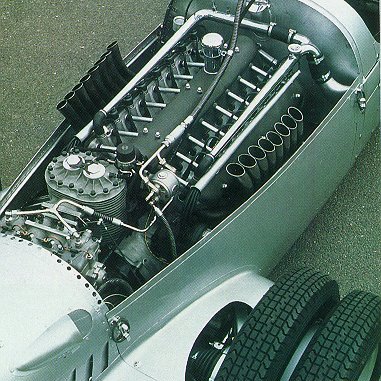
 Technical View and Performance
Technical View and Performance


The famous V16 engine of the Typ C
Technical View
The race car that Porsche designed was based on a mid-engined layout similar to the famous 1923 Benz Tropfenwagen. This unique car was built under the direction of Max Wagner who was now at Daimler-Benz and was raced by his current business partner, Adolf Rosenberger. The engine for this new car would be the V-16 engine that he had started designing earlier for his car, P-wagen. It was designed to 6 liter specifications but would start at 4,360cc and 295 bhp. It had two cylinder blocks inclined at an angle of 45 degrees with a single overhead camshaft to operate the 32 valves. The engine was designed to provide optimum torque at low engine speeds.
The suspension would be all independent but unlike the Mercedes would use half-axles and torsion bars at the front while at the rear it used wishbones and a transverse leaf spring.
The fuel tank was located in the center of the car directly behind the drive who would be placed well towards the front. The chassis tubes were initially used as water carriers from the radiator to the engine but often sprung small leaks.
Additional work needed to be done on the cars behavior during cornering. Accelerating out of a corner would cause the inside rear wheel to spin furiously. This was much abated by the use of a ZF manufactured limited differential for the 1936 season.
The body was made in aluminium originally ment for airplanes. This was necessary since the car wasn't allowed to weight more then 750kg excluding fluids and tires. The body was also subjected to strenuous testing in the wind tunnel of the German Institute for Aerodynamics.
Performance
Much has been written about the difficult handling characteristics of this car but its tremendous acceleration was undeniable. A driver could induce wheelspin at 150 mph! The initial list of drivers was headed by Hans Stuck. The engine for 1936 had grown to the full 6 liters and was now producing 520 bhp. In the hands of new sensation Bernd Rosemeyer the Auto Union Type C dominated the racing world and Rosemeyer was crowned European Champion.
The problem with the car was that since the driver sat almost between the front wheels, it made it harder for him to notice when the rear of the car started to "walk away" in corners. The cars that were used in the mountain races had two wheels on each side, as seen on the pic above, in order to try to use the enormous power better.
A car that considered of a special streamlined body put on the Typ C chassi managed to reach 400kph on a german highway. It is even more remarkable since they had only one kilometer from zero to topspeed. The week after they made another try and Bernd Rosenberger, driver of this "monster", pushed the car up to 440kph. On the way home Bernd lost control over the car since a strong sidewind took him and the car turned around and Bernd Rosenberger was killed.
Back to The Garage




